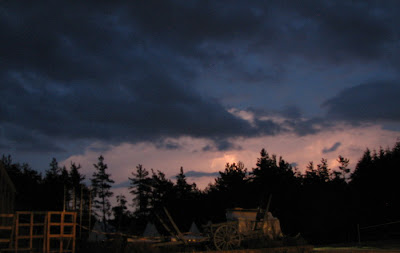Here is part #2 of the post from last week. I am always a little nervous about metaphors, which is part of why I didn't post it right away. But here we go...
This idea of man as God's creation also helped me to understand better the story of the flood, which I prepared for class on Monday. I have heard that sometimes an artist gets particularly attached to a work. It starts out as a project for someone else, but somewhere along the line they invest too much of themselves in it. They feel like a part of themselves is on the canvas. They pour time and energy into it because they feel a sense of duty to make it the best possible. It is their masterpiece. It is intimate and they loathe the idea of giving it away to hang on someone else's wall. For God, that work is man. He deliberately made man "in His image." He longs to keep man close to Him, and unlike a painting, man has been created to interact with the artist, not just please His eyes.
God didn't want to make robots any more than He wanted to make stone sculptures. He gave man the ability to ignore him. The creation does not gaze in unblinking wonder like a Renaissance painting. It can chose to gaze in wonder, and when it does the delight it gives God is infinitely more grand than that which a painted stare could ever produce. But the creation can also chose to turn away, to not look at God. It can look instead at itself. It can instead regard inferior creations, those works that God also loves but which are not comparable. It can worship its own creations. It can chose to drag itself through the mud, to make itself hideous. Worst, it can self-destruct.
That is what mankind was on its way to doing when God decided to send the flood. The wickedness was so great that only one part of the creation had any beauty left. That part was Noah and his family. God, rather than tearing the painting to shreds and starting over from scratch, decided to start over with that piece. When he brushed over that ugly, horrid painting it pained Him more than we can imagine. He had poured himself into that painting. Every single stroke was planned, painstakingly detailed, and meant to contribute to the final product.
God doesn't use a brush. He uses his fingers, capable of the most microscopic detail, and each stroke was made to interact very precisely with every other stroke. Even when all of the strokes had changed colors, moved locations, and twisted themselves at perverted angles, God still saw each of them in it's intricacy and uniqueness, and it pained Him to obliterate them. Still, it needed to be done. The painting was a torment to His eyes. Worse, it was meant to reflect Him, and what it was reflecting was being watched by all the beings in heaven, both those aligned with God and those opposed to Him. We can be sure that Satan mocked God continually for His ugly painting.
So God started it over. Since that day, the painting continues to twist and distort itself. God has always maintained a part of the painting that is beautiful, and that part gives Him intense pleasure. When Satan mocks, God points to that part and says, "See how beautiful that is?" Still, the painting was incapable of maintaining the beauty that God had intended. In the end, God would never be able to keep it.
God was so determined to save His masterpiece that He painted Himself into it. One of those strokes of His finger was Himself. He entered the confusion of the painting, the only stroke to never change color or direction. Satan was enraged. This made the masterpiece infinitely more valuable than he had realized. He was determined to destroy this bold new stroke. All he had to do was turn that one stroke and God would be forever disgraced. He tried, and failed. So he decided that the next best thing would be to remove the stroke from the painting. This he succeeded in doing, because God had planned it all along. The stroke was removed.
Then, to Satan's horror, It came back. It could not be removed! Furthermore, it had created an eternal and unchangeable connection between the masterpiece and the creator. From this stroke and the other strokes closest to it, a growing portion of the painting was becoming beautiful. And thus began the early church...
L'Abeille Boutique
8 years ago









































